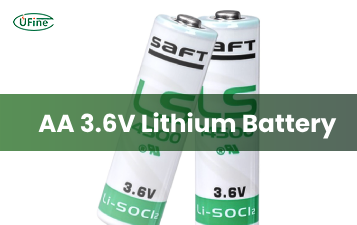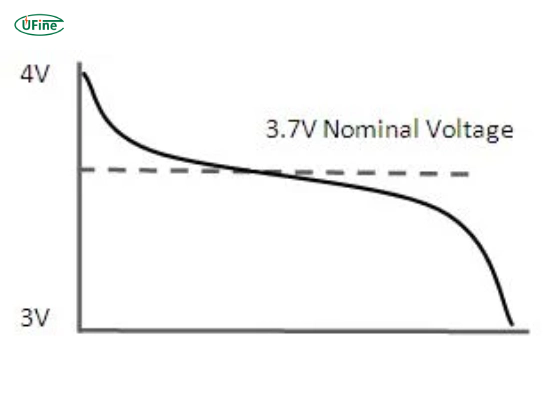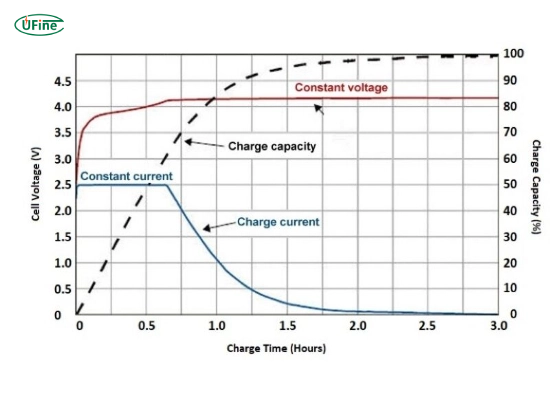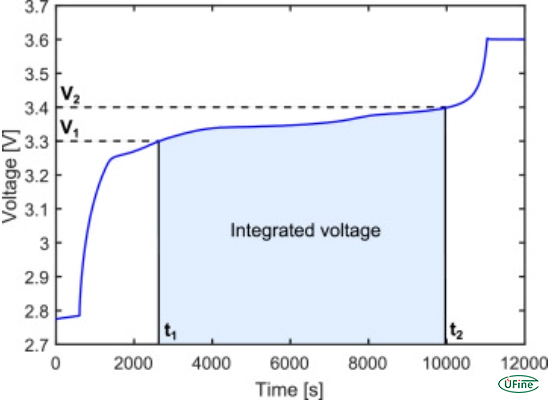Understanding lithium battery voltage is critical for selecting the right power source for your devices. Lithium battery voltage determines not only energy capacity but also affects charging requirements and device compatibility. This comprehensive guide explains key voltage characteristics of major lithium battery types, including Li-ion, LiPo, LiFePO4, and 18650 batteries, with detailed voltage comparison charts and practical compatibility advice.
Part 1. Top rated lithium battery types comparison
| Feature | Li-ion | LiPo | LiFePO4 | 18650 |
|---|---|---|---|---|
| Nominal Voltage | 3.7V | 3.7V | 3.2V | 3.6V-3.7V |
| Max Charge Voltage | 4.2V-4.3V | 4.2V-4.3V | 3.6V-3.8V | 4.2V |
| Cycle Life | 300-500 | 200-300 | 2000+ | 500-1000 |
| Energy Density | High | Very High | Medium | High |
| Top Rated Uses | Smartphones, Laptops | Drones, RC Vehicles | Solar Storage, EVs | Flashlights, Power Banks |
Part 2. Nominal voltage of various lithium battery types
What is lithium battery nominal voltage?
The nominal voltage of a battery refers to the average voltage that a battery cell is expected to operate within during its discharge cycle. It’s an approximate value used to characterize a battery’s voltage for general understanding and compatibility with electronic devices. For instance, a battery labeled as having a nominal voltage of 3.7 volts means that it typically operates around that voltage level during its discharge.
Li-ion Batteries Nominal Voltage
Li-ion (Lithium-Ion) batteries are prevalent in various electronics. The nominal voltage of a single Li-ion cell typically ranges between 3.6 to 3.7 volts. However, when these cells are connected in series, the overall voltage increases proportionally to the number of cells connected. For instance, a series connection of three Li-ion cells (each with a nominal voltage of 3.7 volts) results in an overall voltage of 11.1 volts (3.7V * 3 cells).
LiPo Batteries Nominal Voltage
LiPo (Lithium Polymer) batteries, similar to Li-ion, often have a nominal voltage of approximately 3.7 volts per cell. However, when connected in series, the overall voltage changes accordingly. For example, suppose two LiPo cells with a nominal voltage of 3.7 volts each are connected in series. In that case, the total voltage becomes 7.4 volts (3.7V * 2 cells).
LiFePO4 Batteries Nominal Voltage
LiFePO4 (Lithium Iron Phosphate) batteries maintain a nominal voltage of around 3.2 volts per cell. When these cells are connected in series, the overall voltage output adjusts accordingly. For example, a series connection of four cells at 3.2 volts delivers a general 12.8 volts (3.2V * 4 cells).
18650 Batteries Nominal Voltage
18650 batteries, commonly associated with Li-ion chemistry, typically exhibit a nominal voltage range of 3.6 to 3.7 volts per cell. However, in specific instances, particularly with certain LiFePO4 (Lithium Iron Phosphate) chemistry variants, 18650 cells might have a nominal voltage of 3.2 volts per cell. When connected in series, these cells alter the overall voltage output accordingly—for instance, linking five cells with a nominal voltage of 3.2 volts, each resulting in 16 volts (3.2V * 5 cells).
Part 3. Lithium battery charging and discharging parameters
Charge Voltage
Different types of lithium batteries have varying maximum charge voltages:
- Li-ion Batteries: Typically have a max charge voltage between 4.2 to 4.3 volts per cell.
- LiPo Batteries: Share a similar range with Li-ion batteries, ranging from 4.2 to 4.3 volts per cell.
- LiFePO4 Batteries: Generally possess a lower max charge voltage, approximately 3.6 to 3.8 volts per cell.
For example, let’s consider a scenario in which Li-ion and LiFePO4 batteries are used in a similar device. The Li-ion battery might have a maximum charge voltage of 4.2 volts per cell, while the LiFePO4 battery would have a lower maximum charge voltage of 3.6 volts per cell.
Discharge Cutoff Voltage
Discharge cutoff voltages also vary across different lithium battery types:
- Li-ion and LiPo Batteries: Typically have a discharge cutoff voltage of around 2.5 to 3.0 volts per cell.
- LiFePO4 Batteries: Often possess a higher discharge cutoff voltage, approximately 2.8 to 3.2 volts per cell.
For instance, if we retake Li-ion and LiFePO4 batteries in a similar device setup, the Li-ion battery might have a discharge cutoff voltage of 2.5 volts per cell. In comparison, the LiFePO4 battery would have a higher discharge cutoff voltage of 2.8 volts per cell.
How to Measure Lithium Battery Voltage?
Using a multimeter is the most accurate way to check lithium battery voltage. Set the device to DC voltage measurement, and connect the red probe to the positive terminal and the black to the negative. Healthy lithium battery voltage readings should be between 3.0V (discharged) to 4.2V (fully charged).
Part 4. Influence of lithium battery voltage
Lithium Battery Chemistry: Different lithium battery chemistries have distinct voltage characteristics. For instance, LiFePO4 batteries typically have a lower nominal voltage (around 3.2 volts per cell) than Li-ion batteries (about 3.6 to 3.7 volts per cell).
Voltage Range: Lithium batteries exhibit varying voltage ranges at different charge states. For instance, a fully charged battery may reach around 4.2 volts per cell, while a discharged battery might measure about 3.0 volts per cell.
Temperature Impact: Temperature plays a crucial role in lithium battery voltage. Elevated temperatures can elevate voltage readings, while colder temperatures might reduce voltage output.
Voltage Sag: Lithium batteries may experience voltage sag under heavy loads, causing a momentary voltage drop. This phenomenon occurs when the battery supplies a high current.
Internal Resistance: Increased internal resistance due to aging can lead to voltage drops during high-demand or rapid discharging, impacting overall battery performance.
Cell-to-Cell Variability: Even within the same batch, slight cell manufacturing variations might cause minor voltage output discrepancies among lithium batteries.
Part 5. Lithium battery voltage considerations for device compatibility
Matching Voltage to Device Requirements
Matching a power source’s voltage to a device’s specific requirements is critical for seamless functionality and safety. Several examples illustrate this:
Consumer Electronics: Devices like smartphones and laptops often operate within specific voltage ranges. For instance, a smartphone might require a charging voltage of 5 volts, and using a charger with an incompatible voltage could potentially damage the device.
Automotive Applications: Electric and hybrid cars require battery systems to be compatible with specific voltages to ensure safe and efficient operation. Deviating from the recommended voltage can affect performance and safety.
Industrial Machinery: Various industrial machines have stringent voltage requirements. For instance, CNC machines or robotics often operate within precise voltage parameters for stable and accurate functionality.
Voltage Adaptations for Specialized Applications
Voltage adaptations cater to specialized applications and industries that demand tailored voltage solutions. Several instances highlight this need:
Medical Devices: Medical equipment, such as MRI machines or pacemakers, requires precise and stable voltage delivery to ensure patient safety and device reliability.
Aerospace Technology: Avionics systems in aircraft require voltage stabilization to handle varying power conditions during flight and ensure uninterrupted operation.
Telecommunications: Networking equipment and telecommunications infrastructure demand specific voltage regulations to maintain data transmission reliability and network stability.
Renewable Energy Systems: Solar panels and wind turbines require voltage converters to regulate the variable output from these sources to match the grid or storage system’s voltage requirements.
Looking for specific battery solutions? Check our guide on how to choose lithium batteries or compare 18650 battery specifications.
Part 6. FAQs about lithium battery voltage
What is the standard voltage of lithium battery?
The standard lithium battery voltage ranges between 3.2V to 4.2V depending on chemistry. Most common lithium-ion batteries operate at 3.7V nominal voltage, while lithium iron phosphate (LiFePO4) batteries use 3.2V per cell.
Are all lithium batteries 3.7 volts?
No, lithium battery voltage varies by type. While most Li-ion and LiPo batteries are 3.7V, LiFePO4 batteries typically operate at 3.2V, and some specialty lithium batteries may have different voltage ranges.
What voltage is too high for lithium batteries?
For most lithium-ion batteries, voltages above 4.2V per cell are considered too high and may cause damage. Always refer to the manufacturer’s specifications for exact maximum voltage limits.
How do I check lithium battery voltage?
A digital multimeter set is used for DC voltage measurement. Connect the red probe to the positive terminal and black to negative. A healthy lithium battery should read between 3.0V (discharged) to 4.2V (fully charged).
What voltage is 50% charge for lithium batteries?
For 3.7V lithium-ion batteries, 50% charge typically corresponds to about 3.6V-3.7V. For LiFePO4 (3.2V nominal), 50% charge is approximately 3.25V.
Can I mix different voltage lithium batteries?
No, mixing different voltage lithium batteries can lead to improper charging, reduced performance, and potential safety hazards. Always use batteries with matching voltage ratings.
How does temperature affect lithium battery voltage?
Cold temperatures temporarily reduce voltage output (by 0.3V-0.5V at freezing), while high temperatures may increase voltage readings. These effects are temporary and voltage normalizes at room temperature.
Related Tags:
More Articles

What You Need to Know About AA 3.6V Lithium Battery
Learn all about AA 3.6V lithium batteries—voltage, size, capacity, uses, and the best replacements. Discover why they’re powerful, and highly reliable.
What Are Lithium Salts and Why They Matter in Battery Electrolytes
Lithium salts in electrolytes are key to battery performance, powering everything from phones to EVs and shaping the future of clean energy.
Lithium AAA Battery Guide: Power, Performance & Chargers
Explore lithium AAA batteries—voltage, capacity, weight, top brands, and more. Learn how to choose the best battery for your device and why it really matters.
How to Calculate Watts, Volts, and Amps (With Simple Formulas and Examples)
Learn how to calculate watts, volts, and amps for lithium batteries with simple formulas and examples, ideal for EVs, solar, and energy systems.
Comprehensive Analysis of U.S. Tariffs on Chinese Lithium Batteries
U.S. tariffs on Chinese lithium batteries in 2025 impact costs, supply chains, and EV, energy storage, and electronics industries globally.






